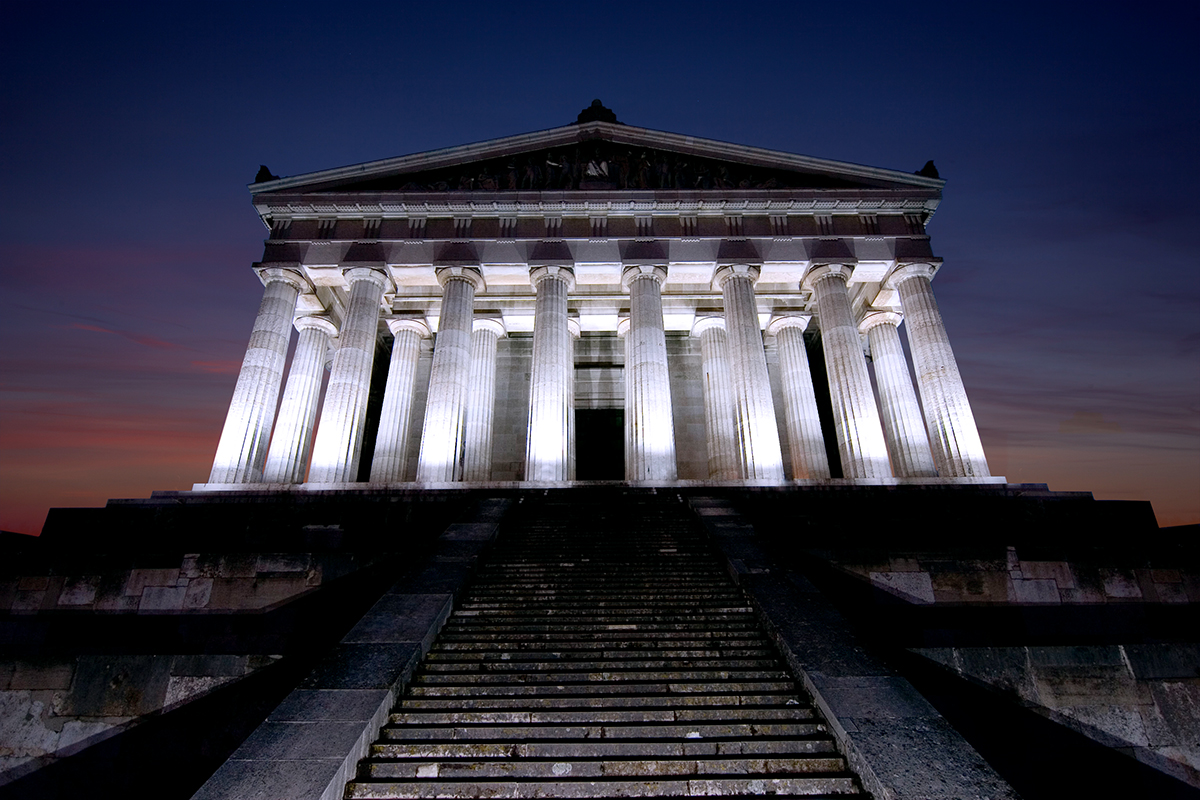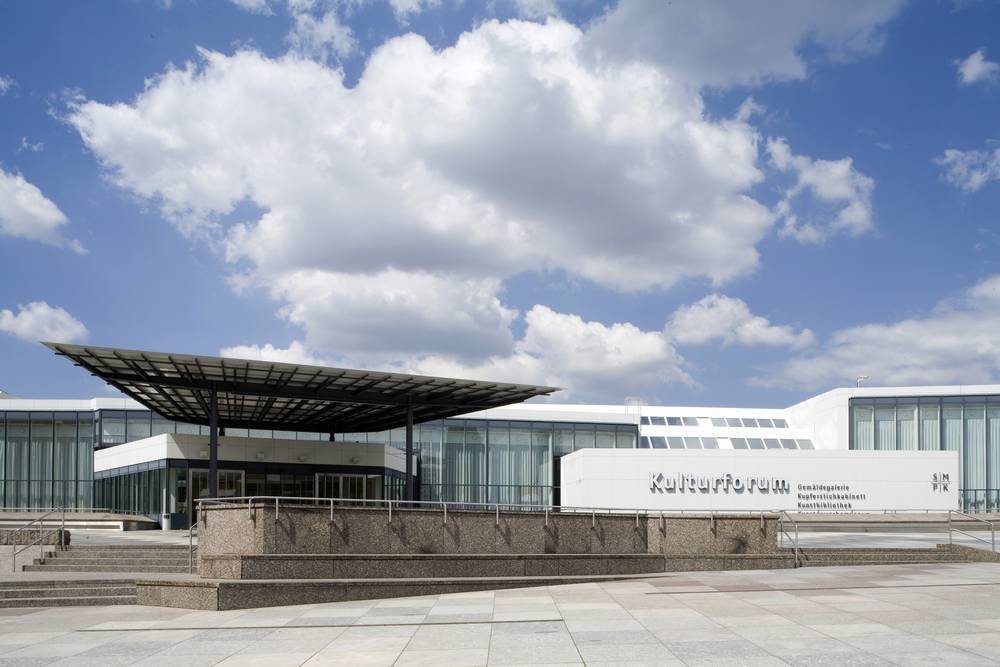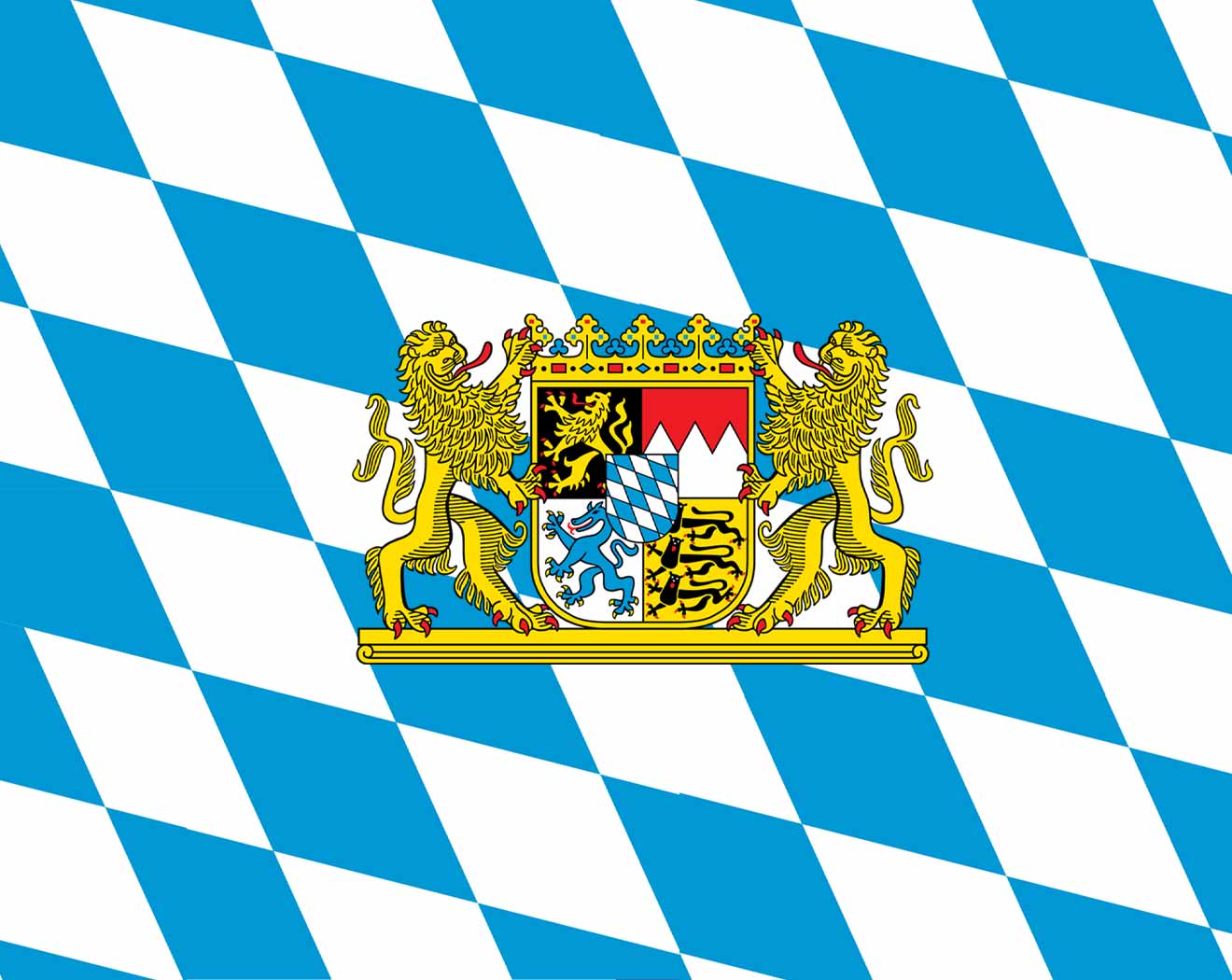
Deutsch-Chinesische Enzyklopädie, 德汉百科
 Museum
Museum









从雷根斯堡沿多瑙河向下游前行10公里,便到了瓦哈拉(Walhalla)。这座视野开阔的大理石神殿是19世纪在国王路德维希一世的主持下,由莱奥 (Leo)和克伦策(Klenze)按照多立克式的雅典神殿(Parthenon in Athen)的式样建造的。神殿内陈列着半身塑像,纪念德语地区的各重要人物。瓦尔哈拉神殿(Walhalla)是一座纪念“值得赞扬和尊敬的德国人”,包括“历史上说德语的著名人物 – 政治家、君主、科学家和艺术家”的名人堂[1],这是一座新古典主义建筑,位于德国巴伐利亚州雷根斯堡以东的多瑙河畔。1807年,巴伐利亚王储路德维希一世进行了构想,当他即位后,在1830年到1842年,由建筑师利奥·冯·克伦策修建。瓦尔哈拉神殿拥有65块牌匾和130人的半身像,覆盖2000年历史;最早的人物则是公元9年在条顿堡森林战役中获胜的阿米尼乌斯。
In der Gedenkstätte Walhalla in Donaustauf im bayerischen Landkreis Regensburg werden – ursprünglich auf Veranlassung des bayerischen Königs Ludwig I. – seit 1842 bedeutende Persönlichkeiten „teutscher Zunge“ mit Marmorbüsten und Gedenktafeln geehrt. Benannt ist sie nach Walhall, der Halle der Gefallenen in der nordischen Mythologie. Der Architekt war Leo von Klenze.
Zur Eröffnung im Jahre 1842 wurden 160 Personen mit 96 Büsten und, in den Fällen fehlender authentischer Abbildungen oder bei Handlungen wie dem Rütlischwur, 64 Gedenktafeln geehrt. Gegenwärtig umfasst die Sammlung 131 Büsten und 65 Gedenktafeln, die an Personen, Taten und Gruppen erinnern. 13 der Geehrten sind Frauen. Jedermann kann eine zu ehrende Persönlichkeit aus dem germanischen Sprachzweig frühestens 20 Jahre nach deren Tod vorschlagen und trägt dann gegebenenfalls die Kosten für die Anfertigung und Aufstellung der Büste. Über die Neuaufnahmen entscheidet der Bayerische Ministerrat.
ヴァルハラ神殿(ヴァルハラしんでん、Walhalla)は、「賞賛に値する著名なドイツ人」の殿堂である[1]。ドイツ語を母語とするドイツ史上の有名人、すなわち政治家、支配者、科学者、芸術家などを祭った、バイエルン州レーゲンスブルクの東のドナウ川岸の丘にある新古典主義の建築物である[1]。1807年、バイエルン王国の皇太子だったルートヴィヒ1世が構想し、建築家レオ・フォン・クレンツェが1830年から1842年に建設した。ヴァルハラ神殿はドイツの著名人について65枚の銘板と130体の胸像を収めており、2000年間のドイツの歴史を網羅している。祭られている最古の人物は、紀元9年にトイトブルク森の戦いに勝利したアルミニウスである。
The Walhalla is a hall of fame that honours laudable and distinguished people in German history – "politicians, sovereigns, scientists and artists of the German tongue";[1] thus the celebrities honoured are drawn from Greater Germany, a wider area than today's Germany, and even as far away as Britain in the case of several Anglo-Saxons who are honoured. The hall is a neo-classical building above the Danube River, in Donaustauf, east of Regensburg in Bavaria.
The Walhalla is named for the Valhalla of Norse Paganism. It was conceived in 1807 by Crown Prince Ludwig I of Bavaria in order to support the gathering momentum for the unification of the many German states. Following his accession to the throne of Bavaria, construction took place between 1830 and 1842 under the supervision of the architect Leo von Klenze. The memorial displays some 65 plaques and 130 busts covering 2,000 years of history, beginning with Arminius, victor at the Battle of the Teutoburg Forest in AD 9.
Le Walhalla est un temple néo-dorique en marbre situé à Donaustauf au bord du Danube, à 10 km en aval de Ratisbonne, en Bavière, Allemagne.
Il Walhalla è un tempio neoclassico ubicato a Donaustauf, nei pressi di Ratisbona, su una collina posta lungo le sponde del Danubio.
El Walhalla (del alemán Walhalla y este del nórdico antiguo Valhöll; lit. ‘salón de los caídos’) es un imponente templo neoclásico cuyo propósito es servir de monumento y salón de la fama a «alemanes laureados y distinguidos». Se levantó a orillas del río Danubio a seis kilómetros hacia el este de Ratisbona, en Baviera, Alemania.[cita requerida]
Fue concebido por el Rey Luis I de Baviera (el abuelo de Luis II) y construido entre 1830 y 1842 bajo diseños de Leo von Klenze, que también fue responsable del Befreiungshalle, también cerca de Ratisbona sobre el Danubio. El Walhalla debe su nombre al salón de los dioses de la mitología germánica (y nórdica) siendo el equivalente al Olimpo griego. Es una copia perfecta del Partenón de Atenas, sostenido por 52 columnas dóricas.1En su interior alberga unas 65 placas y bustos de 130 personas ilustres cubriendo 2000 años de historia. El más antiguo es Arminio, victorioso en la Batalla del bosque de Teutoburgo en el año 9 d. C.
Fue concebido en 1807 por el príncipe heredero Luis I de Baviera con el fin de respaldar el impulso que se estaba acumulando para la unificación de los muchos estados alemanes. Tras su ascenso al trono de Baviera, la construcción se llevó a cabo entre 1830 y 1842 bajo la supervisión del arquitecto Leo von Klenze.
Mientras que el Valhalla de la Mitología nórdica sirvió como hogar para aquellos gloriosamente muertos en batalla, Ludwig pretendía que su Walhalla no solo fuera para guerreros sino también para científicos, escritores y clérigos, y específicamente incluía tanto a hombres como a mujeres. Décadas antes de la fundación del Estado alemán moderno en 1871, "Alemán" se entendía como "germánico", e incluía antiguos germánicos (gótico, vándalo, lombardos, anglosajón) así como medieval y moderno austriaco, holandés, sueco y suizo cifras.
Вальха́лла (нем. Walhalla) — зал славы выдающихся исторических личностей, принадлежащих к германской культуре, расположенный на высоком левом берегу Дуная в 10 км к востоку от города Регенсбурга (Бавария, Германия). Согласно скандинавской и немецкой мифологиям Вальхалла — место посмертного обитания павших в битве героев, доставляемых туда воинственными девами — Валькириями. Здание в неогреческом стиле, повторяющее в общих чертах архитектуру Парфенона афинского Акрополя, построено архитектором Лео фон Кленце, известным в России возведением здания Нового Эрмитажа в Санкт-Петербурге. Размеры Вальхаллы почти совпадают с размерами Парфенона. Его длина составляет 48,5 м, ширина — 14 м и высота — 15,5 м. Как и Парфенон, германский монумент имеет 8 х 17 колонн дорического ордера по главному и боковым фасадам[1]



Das Germanische Nationalmuseum – Leibniz-Forschungsmuseum für Kulturgeschichte (GNM) in Nürnberg ist das größte kulturgeschichtliche Museum des deutschsprachigen Raums. Es beherbergt rund 1,3 Millionen Objekte, von denen 25.000 ausgestellt sind,[3] von der Frühzeit bis zur unmittelbaren Gegenwart.[4] Mit über 435.000 Besuchern pro Jahr zählt es zu den meistbesuchten Museen in Deutschland.
日耳曼国家博物馆(德语:Germanische NationalMuseum,GNM),位于德国纽伦堡,成立于1852年,是德国乃至全欧洲最大的博物馆之一,全馆共有120万件展品。 博物馆由一位弗兰肯男爵建立于1852年,它是在一座中世纪修道院的基础之上改建而来。成立之初的目标是包含所有可获得的德国文学、艺术和历史。1871年德意志帝国成立后,该博物馆很自然地成为了德国的国家博物馆。
日耳曼国家博物馆的展品非常丰富,包括了从石器时代到现代的文物和艺术品。实际上展馆内的内容不仅仅局限于德国国内,整个说德语的日耳曼地区内的文物都是博物馆收藏的对象。[3]它拥有17个固定展厅,一个由2万件展品组成的主题展向游客们展示了德国文化从石器时代的手斧发展到德国当代艺术家约瑟夫·博伊斯著名艺术品“毡毛外套”的历程。除固定展览外,该博物馆还会经常组织进行关于德意志文化的主题展览。实际上,日耳曼国家博物馆不仅仅担负着展览的功能,它更像是一个研究中心。除展厅外,它还包括了一个历史档案馆、一个艺术品档案馆、一个绘画与印刷品收藏室。它那向公众开放的图书室内拥有50万本关于欧洲艺术和文化历史的卷帙。它还拥有15个专门负责维护和修复艺术品的专门工作室,这些工作室除维护本馆自己的收藏品外,还负责为应用科学大学的实习生们提供文物保养方面的实践机会。博物馆还有两个艺术教育中心和一份与博物馆同名的出版物。



香榭丽舍大皇宫(法语:Grand Palais des Champs-Élysées,法语发音:[ɡʁɑ̃ palɛ de ʃɑ̃z‿elize]),通称大皇宫(法语:Grand Palais),位于香榭丽舍大道,是为了举办1900年世界博览会所兴建的展览馆,现为巴黎美术博物馆所在地,由建筑师亨利·德格拉纳、阿尔贝·卢韦、阿尔贝-费利克斯-泰奥菲勒·托马和夏尔·吉罗共同建造,正面长240米、高43米。和小皇宫及亚历山大三世桥修建于同一时期。虽然中文译名有“皇宫”一词,但巴黎大皇宫及小皇宫并非皇家宫殿。
Das Grand Palais (deutsch „Großer Palast“) ist ein für die Weltausstellung im Jahr 1900 in Paris errichtetes Ausstellungsgebäude. Es stellt mit dem gegenüberliegenden Petit Palais und der benachbarten Pont Alexandre III ein bedeutendes Architekturensemble der Belle Époque dar. Nach unterschiedlichen Nutzungen dient es heute den staatlichen Museen als Galerie für Wechselausstellungen.


 Architecture
Architecture
 Art
Art
 Lazio
Lazio

 Toscana
Toscana
 Bavaria
Bavaria
 Vacation and Travel
Vacation and Travel
 Hessen
Hessen
 Berlin
Berlin
 California-CA
California-CA
 Ile-de-France
Ile-de-France
 2024 Summer Olympics
2024 Summer Olympics
 New York-NY
New York-NY